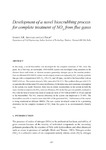Development of a novel bioscrubbing process for complete treatment of NOx from flue gases

Ver/
Use este enlace para citar
http://hdl.handle.net/2183/12841Coleccións
Metadatos
Mostrar o rexistro completo do ítemTítulo
Development of a novel bioscrubbing process for complete treatment of NOx from flue gasesData
2007Cita bibliográfica
Biotechniques for Air Pollution Control II, 2007: 457-468. ISBN: 978-84-9749-258-4
Resumo
[Abstract] In this study, a novel bioscrubber was developed for the complete treatment of NOx from flue gases. As a first step, an autotrophic ANNAMOX system was developed using ammonia as the electron donor and nitrate as electron acceptor generating nitrogen gas as the reaction product. Once an efficient ANNAMOX culture was developed, nitrate was replaced by NOx. Initially synthetic flue gas with a composition of 80% N2, 19% CO2 and 100 ppmv was fed to the bioscrubber with an EBRT of 60 sec. The system showed a NOx removal of 20-25 %. The synthetic flue gas with 3-5% oxygen also showed the same NOx removal efficiency. In the latter case, more ammonia consumption in the system was noted. However, there was no nitrate accumulation in the system in both the cases. Inorder to improve the NOX removal efficiency, NO in the flue gas was partially oxidized to NO2 with the help of ozone (one mole of ozone per mole of NO with an EBRT of 10 sec) and fed to the bioscrubber. The NOx removal efficiency in the system was improved to 75-80%. The bioscrubber was able to remove more than 90% of the generated NO3 -. Performance of the reactor is being monitored at different EBRTs. The new system developed seems to be a promising alternative for the complete treatment of NOx from flue gases in an environmentally friendly way.
ISBN
978-84-9749-258-4





